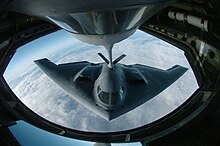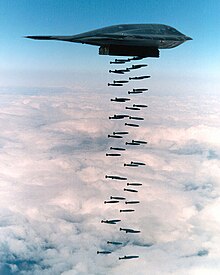Northrop B-2 Spirit
The Northrop Grumman B-2 Spirit is a multi-role stealth heavy bomber, capable of deploying both conventional and nuclear weapons. It is operated exclusively by the United States Air Force. Its development was a milestone in the modernization program of the U.S. Department of Defense. The B-2's stealth technology is intended to aid the aircraft's penetration role in order to survive extremely dense anti-aircraft defenses otherwise considered impenetrable by combat aircraft.
Development
The B-2 started life as a black project known as the High Altitude Penetrating Bomber (HAPB), then became the Advanced Technology Bomber (ATB), and later became the B-2 Spirit. An estimated US$23 billion was secretly spent for research and development on the B-2 in the 1980s. An additional expense was caused by changing its role in 1985 from a high-altitude bomber to a low-altitude bomber, which required a major redesign.
The first B-2 was publicly displayed on 22 November 1988, when it was rolled out of its hangar at Air Force Plant 42, Palmdale, California, where it was built. Its first public flight was on 17 July 1989. The B-2 Combined Test Force, Air Force Flight Test Center, Edwards Air Force Base, California, is responsible for flight testing the engineering, manufacturing and development aircraft.

The original procurement of 135 aircraft was later reduced to 75 in the late 1980s. In his 1992 State of the Union Address, President George H.W. Bush announced total B-2 production would be limited to 20 aircraft (later increased to 21 by refurbishing a test aircraft).[1] This reduction was largely a result of the disintegration of the Soviet Union, which effectively rendered void the Spirit's primary mission.
The cost of the B-2 program in 1994 dollars was reported at $737 million per plane; however, the total cost of the program with development, spares, and facilities averaged over $2.1 billion per plane as of 1997 according to the B-2 program office.[2]
Design
With the B-52 Stratofortress and B-1 Lancer, the U.S. military claims that the B-2 provides the versatility inherent in manned bombers. Its low-observable, or "stealth," characteristics give it the ability to penetrate an enemy's most sophisticated defenses and attack its most heavily defended targets.
The blending of low-observable technologies with high aerodynamic efficiency and large payload gives the B-2 significant advantages over previous bombers. Its range is approximately 6,000 nautical miles (11,100 km) without refueling. Also, its low-observation ability provides the B-2 greater freedom of action at high altitudes, thus increasing its range and giving a better field of view for the aircraft's sensors. With its GPS Aided Targeting System (GATS) combined with GPS-aided bombs such as Joint Direct Attack Munition (JDAM), it can use its passive electronically scanned array APQ-181 radar to correct GPS errors of targets and gain much better than laser-guided weapon accuracy with "dumb" gravity bombs with a GPS-aided "smart" guidance tail kit attached. It can bomb 16 targets in a single pass when equipped with 1,000 or 2,000-pound bombs, or as many as 80 when carrying 500-lb bombs.
The B-2's stealth comes from a combination of reduced acoustic, infrared, visual and radar signatures, making it difficult for defenses to detect, track and engage. Many aspects of the low-observability process remain classified; however, the B-2's composite materials, special coatings and flying wing design contribute to its stealth abilities. The B-2 uses radar absorbent material and coatings, that have required climate-controlled hangars for maintenance.[3]

The B-2 has a crew of two; a pilot in the left seat and mission commander in the right.[4] The B-2 has a provision for a third crew member if required in the future.[5] For comparison, the B-1B has a crew of four and the B-52 has a crew of five.[4] B-2 crews have been used to pioneer sleep cycle research to improve crew performance on long flights. The B-2 is highly automated, and unlike single-seat fighters, one crew member can sleep, use a flush toilet or prepare a hot meal while the other monitors the aircraft.[6]
Operational history
The first operational aircraft, christened Spirit of Missouri, was delivered on December 17 1993. The B-2 fleet is based at Whiteman Air Force Base in Missouri. Depot maintenance for the B-2 is accomplished by United States Air Force contractor support and managed at the Oklahoma City Air Logistics Center, Tinker Air Force Base, Oklahoma.[4] Originally designed to employ nuclear weapons, modern usage has shifted towards a flexible role with conventional and nuclear capability.
The prime contractor, responsible for overall system design and integration, is Northrop Grumman Integrated Systems Sector. Boeing Integrated Defense Systems, Hughes Aircraft (now Raytheon), General Electric Aircraft Engines and Vought Aircraft Industries, are members of the aircraft contractor team. Another contractor, responsible for aircrew training devices (weapon system trainer and mission trainer) is Link Simulation & Training, a division of L-3 Communications formerly Hughes Training Inc. (HTI).[7] Link Division, formerly known as CAE - Link Flight Simulation Corp. Link Simulation & Training is responsible for developing and integrating all aircrew and maintenance training programs.
Combat

The B-2 has seen service in three separate campaigns. Its debut was during the Kosovo War in 1999. The B-2 first introduced the satellite guided JDAM in combat use. Since then, the aircraft has operated over Afghanistan in Operation Enduring Freedom and Iraq in Operation Iraqi Freedom. During the Iraq campaign, B-2s were temporarily operated from Diego Garcia. Later missions to Iraq launched from Whiteman Air Force Base in Missouri. This resulted in missions lasting over 30 hours and one mission of over 50 hours.
The Pentagon's Operational Test and Evaluation 2003 Annual Report noted that the B-2's serviceability for FY03 was still inadequate, mainly due to maintenance on the B-2's Low Observable materials. The evaluation also noted that the Defensive Avionics suite also had shortcomings with pop-up threats.[8] Despite these problems the B-2 reached full operational capability in December 2003.[4] The B-2 maintained high mission capable rates for Operation Iraqi Freedom, dropping 583 JDAMs during the campaign.[9]
Recent events
Noshir Gowadia, a design engineer that worked on the B-2's propulsion system, was arrested in October 2005 for selling classified information related to the B-2 to foreign countries. His trial is scheduled for 12 February 2008.[10][11]
Incidents and accidents
There are no known losses of the B-2 Spirit either in peace or wartime.
Operators

- 57th Wing, Nellis Air Force Base
- 325th Weapons Squadron, Whiteman Air Force Base
- 715th Weapons Squadron (deactivated)
List of B-2 bombers

| Designation | Tail # | Formal name | |
|---|---|---|---|
| AV-1 | 82-1066 | Spirit of America | |
| AV-2 | 82-1067 | Spirit of Arizona | |
| AV-3 | 82-1068 | Spirit of New York | |
| AV-4 | 82-1069 | Spirit of Indiana | |
| AV-5 | 82-1070 | Spirit of Ohio | |
| AV-6 | 82-1071 | Spirit of Mississippi | |
| AV-7 | 88-0328 | Spirit of Texas | |
| AV-8 | 88-0329 | Spirit of Missouri | |
| AV-9 | 88-0330 | Spirit of California | |
| AV-10 | 88-0331 | Spirit of South Carolina | |
| AV-11 | 88-0332 | Spirit of Washington | |
| AV-12 | 89-0127 | Spirit of Kansas | |
| AV-13 | 89-0128 | Spirit of Nebraska | |
| AV-14 | 89-0129 | Spirit of Georgia | |
| AV-15 | 90-0040 | Spirit of Alaska | |
| AV-16 | 90-0041 | Spirit of Hawaii | |
| AV-17 | 92-0700 | Spirit of Florida | |
| AV-18 | 93-1085 | Spirit of Oklahoma | |
| AV-19 | 93-1086 | Spirit of Kitty Hawk | |
| AV-20 | 93-1087 | Spirit of Pennsylvania | |
| AV-21 | 93-1088 | Spirit of Louisiana | |
| AV-22–AV-165 canceled | |||
- Source: FAS.org[12]
B-2 on display

Because of their cost, rarity and combat value it is unlikely any B-2 will be placed on permanent display in the near future (or anytime before airframe retirement). However, they are periodically on temporary ground display at various air shows, including one at Tinker Air Force Base, Midwest City, Oklahoma in June 2005. In 2004, the static test mock-up for the B-2 was placed on display at the National Museum of the United States Air Force near Dayton, Ohio. The mock-up had been used for structural testing, and at one point was tested to the point of destruction. The Museum's restoration team spent over a year reassembling the fractured airframe, and patches can clearly be seen on the exterior of the airframe where fractured sections have been reattached.
From 1989 to 2004, the South Dakota Air and Space Museum located on the grounds of Ellsworth Air Force Base displayed a 10-ton, 3/5 scale "Honda Stealth," a mock-up of a stealth bomber built by North American Honda in 1988 for a national automobile campaign. The mock-up is not an actual replica of a B-2, but was close enough to create a stir that Honda had cracked national security, as the B-2 project was still officially classified in 1988.[13] Honda donated the model to the Museum in 1989, with the stipulation the model be destroyed if it were replaced with a different aircraft. The Honda Stealth was dismantled and replaced with a B-1 Lancer aircraft in 2005.[14][15]
A B-2 Spirit participated in the Air Force Memorial dedication ceremony on 14 October 2006.
Specifications (B-2A Block 30)

Data from Global Security[16]
General characteristics
- Crew: 2
Performance
- Thrust/weight: 0.205
Armament
- 2 internal bays for 50,000 lb (22,700 kg) of ordnance.[17]
Later avionics and equipment improvements allow B-2A to carry JSOW and GBU-28s as well. The Spirit is also designated as a delivery aircraft for the AGM-158 JASSM when the missile enters service.
References
Notes
- ^ President George H. Bush's State of the Union Address, 28 January 1992.
- ^ United States General Accounting Office (GAO) B-2 Bomber: Cost and Operational Issues (Letter Report, 08/14/97, GAO/NSIAD-97-181).
- ^ Fulghum, D.A. "Away Game". Aviation Week & Space Technology, 8 January 2007. [1].
- ^ a b c d B-2 USAF fact sheet
- ^ B-2 Spirit page, Northrop Grumman
- ^ Tirpak, John A. "With the First B-2 Squadron." Air Force Magazine: Journal of the Air Force Association, Vol. 79, No. 4., April 1996.
- ^ B-2 Aircrew Training System
- ^ Pop-up is an informative call of a contact that has suddenly appeared inside of meld/CCR/briefed range.
- ^ Air Force programs: B-2
- ^ FBI Honolulu Press Release
- ^ Gowadia case
- ^ B-2 page on fas.org
- ^ Black Hills Attractions
- ^ Museum slices stealth display
- ^ B-1 to go on display in museum
- ^ B-2 specifications, GlobalSecurity.com
- ^ Spick 2000, p. 340.
Bibliography
- CNN - B-2 stealth bombers make combat debut - 24 March 1999
- Donald, David, ed. Black Jets: The Development and Operation of America's Most Secret Warplanes. Norwalk, Connecticut: AIRtime Publishing Inc., 2003. ISBN 1-880588-67-6.
- Richardson, Doug. Northrop B-2 Spirit (Classic Warplanes). New York: Smithmark Publishers Inc., 1991. ISBN 0-8317-1404-2.
- Spick, Mike. The Great Book of Modern Warplanes. St. Paul, Minnesota: MBI Publishing Company, 2000. ISBN 0-7603-0893-4.
- Winchester, Jim, ed. "Northrop B-2 Spirit". Modern Military Aircraft (Aviation Factfile). Rochester, Kent, UK: Grange Books plc, 2004. ISBN 1-84013-640-5.
- The World's Great Stealth and Reconnaissance Aircraft. New York: Smithmark, 1991. ISBN 0-8317-9558-1.
See also
Related development
Related lists
External links
- USAF Fact sheet on B-2 Spirit
- B-2 Spirit page on NorthropGrumman.com
- B-2 page on NASA Langley site
- Pentagon Operational Test and Evaluation 2003 Annual Report
- B-2 Spirit page on GlobalSecurity.org
- B-2 Bomber page on Center for Defense Information web site
- B-2 Spirit Stealth Bomber page on bugimus.com
- B-2 Spirit (Stealth Bomber) page on Aircraft-Info.net
